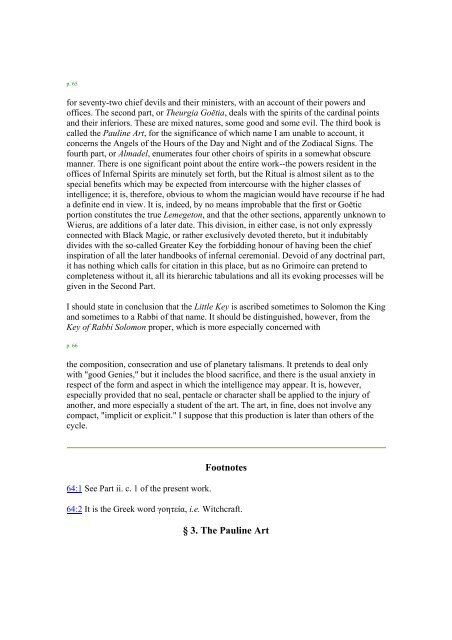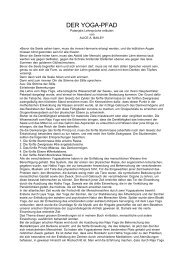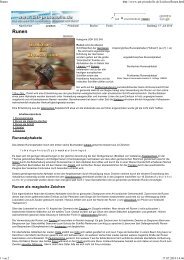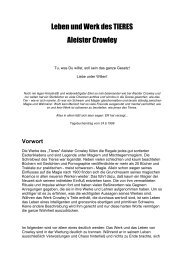The Book of ceremonial Magic
The Book of ceremonial Magic
The Book of ceremonial Magic
You also want an ePaper? Increase the reach of your titles
YUMPU automatically turns print PDFs into web optimized ePapers that Google loves.
p. 65<br />
for seventy-two chief devils and their ministers, with an account <strong>of</strong> their powers and<br />
<strong>of</strong>fices. <strong>The</strong> second part, or <strong>The</strong>urgia Goëtia, deals with the spirits <strong>of</strong> the cardinal points<br />
and their inferiors. <strong>The</strong>se are mixed natures, some good and some evil. <strong>The</strong> third book is<br />
called the Pauline Art, for the significance <strong>of</strong> which name I am unable to account, it<br />
concerns the Angels <strong>of</strong> the Hours <strong>of</strong> the Day and Night and <strong>of</strong> the Zodiacal Signs. <strong>The</strong><br />
fourth part, or Almadel, enumerates four other choirs <strong>of</strong> spirits in a somewhat obscure<br />
manner. <strong>The</strong>re is one significant point about the entire work--the powers resident in the<br />
<strong>of</strong>fices <strong>of</strong> Infernal Spirits are minutely set forth, but the Ritual is almost silent as to the<br />
special benefits which may be expected from intercourse with the higher classes <strong>of</strong><br />
intelligence; it is, therefore, obvious to whom the magician would have recourse if he had<br />
a definite end in view. It is, indeed, by no means improbable that the first or Goëtic<br />
portion constitutes the true Lemegeton, and that the other sections, apparently unknown to<br />
Wierus, are additions <strong>of</strong> a later date. This division, in either case, is not only expressly<br />
connected with Black <strong>Magic</strong>, or rather exclusively devoted thereto, but it indubitably<br />
divides with the so-called Greater Key the forbidding honour <strong>of</strong> having been the chief<br />
inspiration <strong>of</strong> all the later handbooks <strong>of</strong> infernal <strong>ceremonial</strong>. Devoid <strong>of</strong> any doctrinal part,<br />
it has nothing which calls for citation in this place, but as no Grimoire can pretend to<br />
completeness without it, all its hierarchic tabulations and all its evoking processes will be<br />
given in the Second Part.<br />
I should state in conclusion that the Little Key is ascribed sometimes to Solomon the King<br />
and sometimes to a Rabbi <strong>of</strong> that name. It should be distinguished, however, from the<br />
Key <strong>of</strong> Rabbi Solomon proper, which is more especially concerned with<br />
p. 66<br />
the composition, consecration and use <strong>of</strong> planetary talismans. It pretends to deal only<br />
with "good Genies," but it includes the blood sacrifice, and there is the usual anxiety in<br />
respect <strong>of</strong> the form and aspect in which the intelligence may appear. It is, however,<br />
especially provided that no seal, pentacle or character shall be applied to the injury <strong>of</strong><br />
another, and more especially a student <strong>of</strong> the art. <strong>The</strong> art, in fine, does not involve any<br />
compact, "implicit or explicit." I suppose that this production is later than others <strong>of</strong> the<br />
cycle.<br />
Footnotes<br />
64:1 See Part ii. c. 1 <strong>of</strong> the present work.<br />
64:2 It is the Greek word γοητεία, i.e. Witchcraft.<br />
§ 3. <strong>The</strong> Pauline Art
















